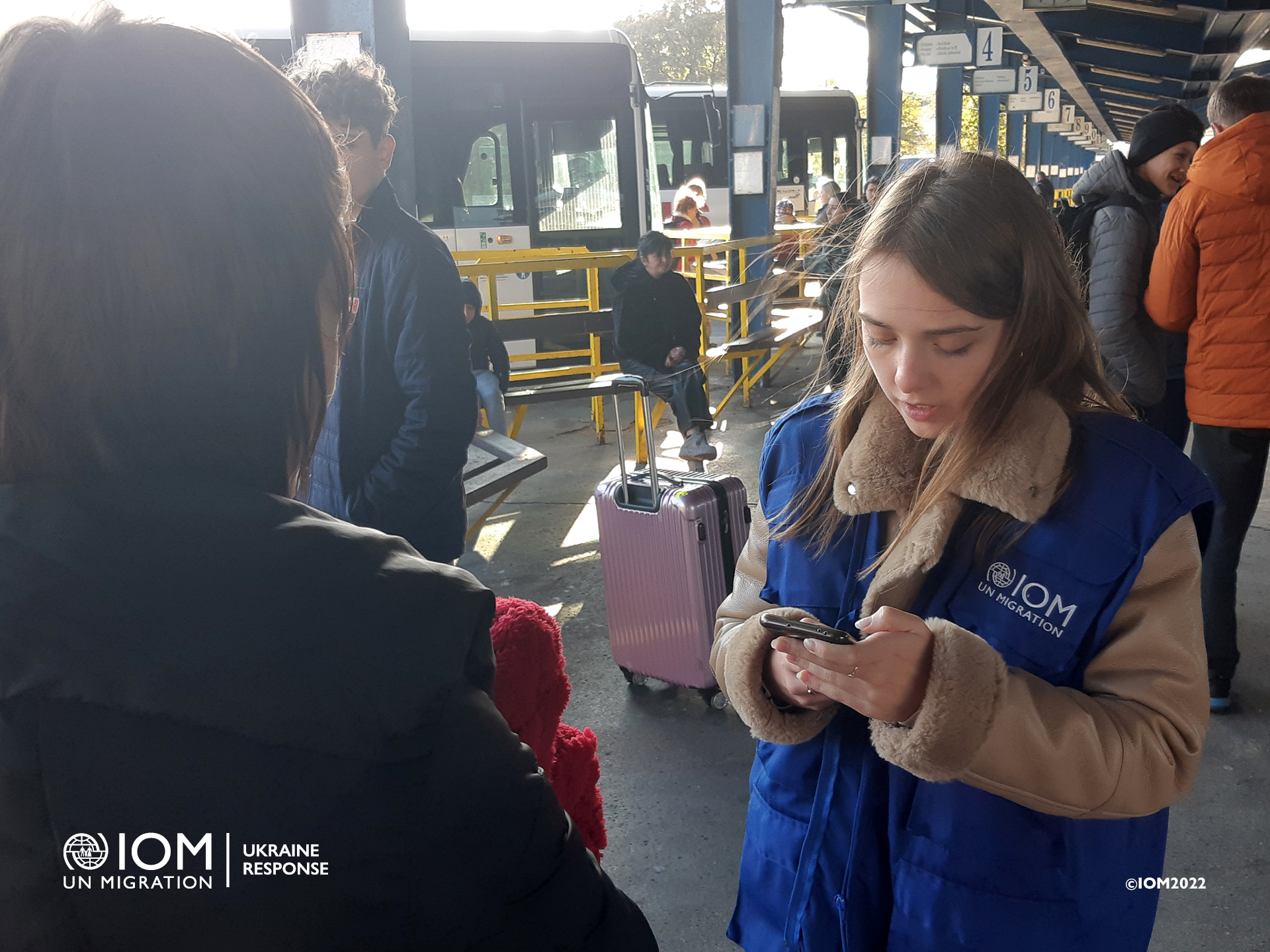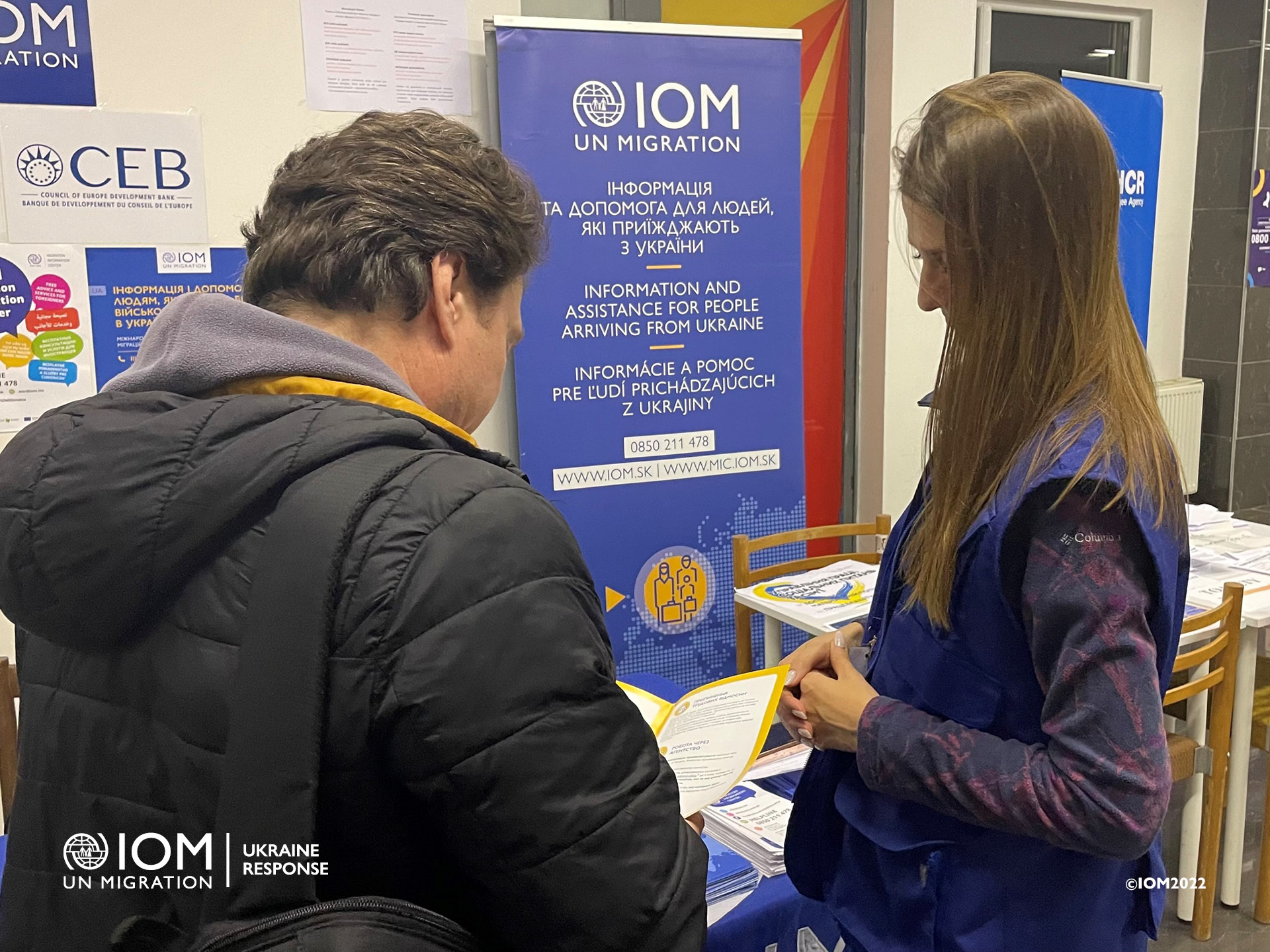Fifty-nine per cent of those interviewed who fled from Ukraine to Slovakia indicated they would return to Ukraine once it was safe, according to IOM Slovakia data. Fifteen per cent of them intended to stay in Slovakia in the long term and 21 per cent did not know their long-term plans.
The data comes from the sixth rapid needs assessment report published on 25 November 2022. The report is based on the analysis of 1,817 face-to-face interviews conducted by the IOM’s Displacement Tracking Matrix team between 9 March and 11 November 2022 with Ukrainian refugees (99%) and third-country nationals (1%) arriving to Slovakia at two border crossing points, two registration centres and one hotspot.

An IOM enumerator at the Bus station in Kosice conducts surveys with displaced people from Ukraine to understand their mobility, needs and intentions. Photo © International Organization for Migration (IOM) 2022.
Profile of interviewees
Most of the respondents were women and girls who accounted for eighty-two per cent in the sample. The average age of the women surveyed was 41 and 45 for men. The overall largest age cohort is 30-39 years (precisely 29%). This represents a slight shift compared to the previously published analysis, where the overall largest age cohort was 40-49 years. The top five regions of origin were Kharkiv (20%), Kyiv (18%), Donetsk (11%), Dnipropetrovsk (8%) and Zakarpattia (7%).
Consistent with previous reports, most of the people interviewed were travelling in a group (76%). Men tended to travel alone more often than women. Seventeen per cent of respondents reported travelling in a group of 10 or more people. For the respondents travelling in a group, 82 per cent reported travelling with immediate family.
Thirteen per cent of groups were travelling with at least one older person (60+) and 2% of groups travelled with a person with disability or a serious health condition. In total, 1,517 children were reported to be travelling with the respondents.
Intended destination
Slovakia was the most common intended destination for seventy-one per cent of respondents. About twenty-three per cent of interviewees indicated another country in Europe (Germany was indicated by 38% of this group of respondents, followed by Czechia, Poland, Switzerland and Austria). The most common reasons for choosing another European country were having family or friends, better protection systems and having accommodation in a destination country.
Destination within Slovakia
Out of the respondents who reported Slovakia as their final destination (1,288 respondents), more than a half intended to stay in the eastern regions of the country (60%). Eleven per cent of the respondents planned on travelling to the region of the capital city (Bratislava region) and 15 per cent were still undecided on their final location in Slovakia. Forty-two per cent of respondents chose Slovakia because of their friends or relatives, 18 per cent consider it to have a better protection system, 15 per cent reported having accommodation there and 9 per cent chose Slovakia because they study there.
The most urgent needs
The majority of respondents (71%) declared their need for support in communicating with their loved ones and in getting information. The other top urgent needs were financial support (65%), documentation and legal support (58%), transportation (53%), support with employment (46%), accommodation (43%) and food (43%).
Almost half of these respondents also declared the need for support with school and education (49%). Forty-three per cent reported a need for accommodation support and 41 per cent needed help with children’s protection and safety.
Type of support received in Slovakia
The majority of respondents (72%) reported that they had received support in communication. Other three top forms of support following communication are documentation and legal services, food and transportation support.
Accommodation was reported to have been received by less than a third of respondents. The least covered needs were support to access school and education, support to return home and psychological counselling.

An IOM consultant at the Michalovce Registration Centre provides displaced people who fled the war in Ukraine with vital information and legal counselling. Photo © International Organization for Migration (IOM) 2022.
Read the report
Find all IOM Slovakia reports here:
https://displacement.iom.int/slovakia
Displacement Tracking Matrix (DTM)The DTM is a system to track and monitor displacement and population mobility. It is designed to regularly and systematically capture, process and disseminate data and information to provide a better understanding of the movements and evolving needs of displaced populations, whether on site or en route, both in country and at the global level. |
With the support of:
The IOM’s DTM activities in the region were made possible with financial support from the Council of Europe Development Bank, France, Foreign, Commonwealth and Development Office, German Federal Foreign Office, Government of Japan, Government of the Republic of Korea, Norwegian Ministry of Foreign Affairs, Swiss Agency for Development and Cooperation, and United States Bureau of Population, Refugees, and Migration
.






![]()
![]()

This activity was generously funded by the U.S. Department of State Bureau of Population, Refugees, and Migration.
 Slovenčina
Slovenčina
 Українська (Україна)
Українська (Україна)
 English
English
